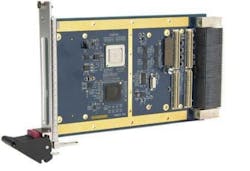3U VPX carrier cards for interfacing PMC and XMC cards to VPX embedded computing systems introduced by Acromag
WIXOM, Mich., 31 March 2011. Acromag Inc. in Wixom, Mich., is introducing the VPX4810 3U VPX carrier cards for interfacing PCI Mezzanine Cards (PMCs) or Express Mezzanine Cards (XMCs) to VPX embedded computing systems in high-performance military, industrial, scientific research, and telephony applications that require high-speed I/O.These carrier cards route power and interface bus signals to a plug-in mezzanine module through the VPX card slot connector. An eight-lane PCI Express bus Gen 2 interface enables rapid data throughput. The carrier cards are available in air-cooled versions that operate in temperatures from 0 to 70 degrees Celsius, or in rugged conduction-cooled and REDI models.The carrier card conforms to VPX VITA 46.0, 46.4, and 46.9 specifications and optionally VITA 48 for Ruggedized Enhanced Design Implementation (REDI). It is also compatible with several VITA 65 OpenVPX module/slot profiles. The card supports 64 I/O lines (P14, VITA 46.9) via the P2 VPX connector, and can accommodate front- and rear-panel I/O access.
The PMC/XMC site uses 64-bit, 66/133 MHz PLX technology with a PCI Express to PCI-X bridge for data transfer rates as fast as 1 gigabyte per second. Users can select a fat pipe (x4) or double-fat pipe (x8) PCI Express interface by adjusting a jumper.
For more information contact Acromag online at www.acromag.com.
